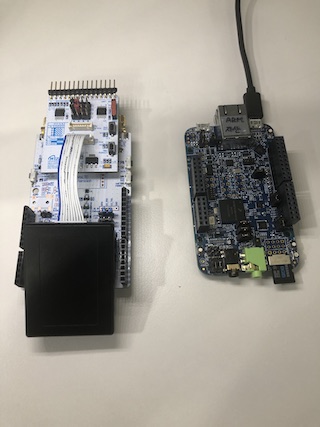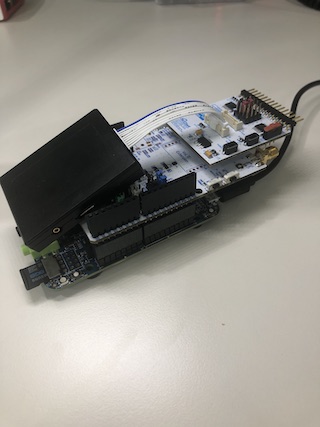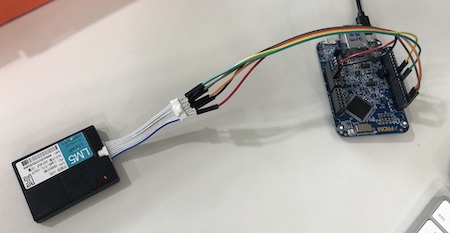K6xF board with BG96 of WIZnet for CatM1 board.
Dependencies: FXAS21002 FXOS8700Q
This document is based on https://os.mbed.com/teams/NXP/code/pelion-example-frdm/
This code could be access via Cat.M1(BG96 module) of SK telecom network in Korea. Need a WIZnet BG96 board or can connect directly to M2Mnet BG96 module and development board.


- FRDM-K64F - onboard Ethernet and onboard SD card holder.
- FRDM-K66F - onboard Ethernet and onboard SD card holder.
-------------------------------


- BG96 RESET = D7
- BG96 PWRKEY = D9
- BG96 TX = D1
- BG96 RX = D0
- BG96 VCC = VCC(5V)
- BG96 GND = GND
Requirement
- FRDM-K64F or FRDM-K66F
- WIZnet BG96 I/F board or M2Mnet BG96 module include SIM card.
Example functionality
This example showcases the following device functionality:
Read onboard FXOS8700Q accelerometer and magnetometer, and report the values as Pelion LWM2M resources (see image below). (FRDM-K66F only) Read onboard FXAS21002 gyroscope and report the values as Pelion LWM2M resources. On user button click, increment Pelion LWM2M button resource. Allow the user to change the state of the board LED from Pelion LWM2M led_state resource and PUT request.
1. Import the application into your desktop:
mbed import http://os.mbed.com/users/Daniel_Lee/code/BG96_K6xF_pelion-example-frdm/ cd BG96_K6xF_pelion-example-frdm
2. Install the CLOUD_SDK_API_KEY
mbed config -G CLOUD_SDK_API_KEY <PELION_DM_API_KEY>
For instructions on how to generate your API key, please see the documentation.
3. Initialize firmware credentials (done once per repository). You can use the following command:
mbed dm init -d "<your company name in Pelion DM>" --model-name "<product model identifier>" -q --force
If the above command does not work for your Mbed CLI, please consider upgrading Mbed CLI to version 1.9.x or above.
4. Compile and program:
mbed compile -t <toolchain> -m <TARGET_BOARD>
(supported toolchains : GCC_ARM / ARM / IAR)
5. If successfully connect to cellular networks(SKTelecom) then you can get below message
[BOOT] Mbed Bootloader [BOOT] ARM: 00000000000000000000 [BOOT] OEM: 00000000000000000000 [BOOT] Layout: 0 83A8 [BOOT] Active firmware integrity check: [BOOT] SHA256: 2DD1793----------------------------------------------------------------- [BOOT] Version: 1563983916 [BOOT] Slot 0 is empty [BOOT] Active firmware up-to-date [BOOT] Application's start address: 0x10400 [BOOT] Application's jump address: 0x10B11 [BOOT] Application's stack address: 0x20030000 [BOOT] Forwarding to application... Starting Simple Pelion Device Management Client example You can hold the user button during boot to format the storage and change the d. M2Mnet(BG96) Power ON Sensors configuration: FXOS8700Q accelerometer = 0xC7 FXOS8700Q magnetometer = 0xC7 Connecting to the network using the default network interface... Connected to the network successfully. IP address: 000:000:000:000:000:000:000:0 Initializing Pelion Device Management Client... Initialized Pelion Device Management Client. Registering... Press the user button to increment the LwM2M resource value... Registered to Pelion Device Management. Endpoint Name: "xx Your Endpoint Name xx" *** Button notification, status Subscribed (6) FXOS8700Q mag: -2.426 x, -0.902 y, -1.611 z [gauss] FXOS8700Q acc: -0.054 x, -0.309 y, 4.306 z [g]
Diff: main.cpp
- Revision:
- 1:42d51cf7cebe
- Parent:
- 0:a9d53048f0b6
- Child:
- 2:fba2c7066355
--- a/main.cpp Mon Mar 25 14:58:08 2019 +0000
+++ b/main.cpp Mon Mar 25 17:18:30 2019 +0000
@@ -21,6 +21,14 @@
#include "simple-mbed-cloud-client.h"
#include "FATFileSystem.h"
#include "LittleFileSystem.h"
+#include "FXOS8700Q.h"
+
+I2C sen_i2c(PTE25, PTE24);
+FXOS8700QAccelerometer sen_acc(sen_i2c, FXOS8700CQ_SLAVE_ADDR1); // Configured for the FRDM-K64F with onboard sensors
+FXOS8700QMagnetometer sen_mag(sen_i2c, FXOS8700CQ_SLAVE_ADDR1);
+
+#define SENSORS_POLL_INTERVAL 1.0
+#define SEND_ALL_SENSORS
// Default network interface object. Don't forget to change the WiFi SSID/password in mbed_app.json if you're using WiFi.
NetworkInterface *net = NetworkInterface::get_default_instance();
@@ -47,11 +55,22 @@
MbedCloudClientResource *button_res;
MbedCloudClientResource *led_res;
MbedCloudClientResource *post_res;
+#ifdef SEND_ALL_SENSORS
+MbedCloudClientResource *res_magnometer_x;
+MbedCloudClientResource *res_magnometer_y;
+MbedCloudClientResource *res_magnometer_z;
+MbedCloudClientResource *res_accelerometer_x;
+MbedCloudClientResource *res_accelerometer_y;
+MbedCloudClientResource *res_accelerometer_z;
+#endif /* SEND_ALL_SENSORS */
// An event queue is a very useful structure to debounce information between contexts (e.g. ISR and normal threads)
// This is great because things such as network operations are illegal in ISR, so updating a resource in a button's fall() function is not allowed
EventQueue eventQueue;
+// When the device is registered, this variable will be used to access various useful information, like device ID etc.
+static const ConnectorClientEndpointInfo* endpointInfo;
+
/**
* PUT handler - sets the value of the built-in LED
* @param resource The resource that triggered the callback
@@ -104,6 +123,50 @@
printf("Registered to Pelion Device Management. Endpoint Name: %s\n", endpoint->internal_endpoint_name.c_str());
}
+/**
+ * Initialize sensors
+ */
+void sensors_init() {
+ printf ("\nSensors configuration:\n");
+
+ sen_acc.enable();
+ sen_mag.enable();
+
+ printf("FXOS8700Q accelerometer = 0x%X\n", sen_acc.whoAmI());
+ printf("FXOS8700Q magnetometer = 0x%X\n", sen_mag.whoAmI());
+
+ printf("\n"); ;
+}
+
+/**
+ * Update sensors and report their values.
+ * This function is called periodically.
+ */
+void sensors_update() {
+ motion_data_counts_t acc_raw, mag_raw;
+
+ printf(" \n");
+
+ sen_acc.getAxis(acc_raw);
+ sen_mag.getAxis(mag_raw);
+
+ printf("FXOS8700Q mag: %7ld x, %7ld y, %7ld z [mgauss] \n", mag_raw.x, mag_raw.y, mag_raw.z);
+ printf("FXOS8700Q acc: %7ld x, %7ld y, %7ld z [mg] \n", acc_raw.x, acc_raw.y, acc_raw.z);
+
+ printf("\r\033[3A");
+
+ if (endpointInfo) {
+#ifdef SEND_ALL_SENSORS
+ res_magnometer_x->set_value((int)mag_raw.x);
+ res_magnometer_y->set_value((int)mag_raw.y);
+ res_magnometer_z->set_value((int)mag_raw.z);
+ res_accelerometer_x->set_value((int)acc_raw.x);
+ res_accelerometer_y->set_value((int)acc_raw.y);
+ res_accelerometer_z->set_value((int)acc_raw.z);
+#endif /* SEND_ALL_SENSORS */
+ }
+}
+
int main(void) {
printf("\nStarting Simple Pelion Device Management Client example\n");
@@ -120,6 +183,8 @@
}
#endif /* USE_BUTTON */
+ sensors_init();
+
// Connect to the Internet (DHCP is expected to be on)
printf("Connecting to the network using the default network interface...\n");
net = NetworkInterface::get_default_instance();
@@ -165,16 +230,13 @@
// Register with Pelion DM
client.register_and_connect();
-#if USE_BUTTON == 1
// The button fires on an interrupt context, but debounces it to the eventqueue, so it's safe to do network operations
button.fall(eventQueue.event(&button_press));
printf("Press the user button to increment the LwM2M resource value...\n");
-#else
+
// The timer fires on an interrupt context, but debounces it to the eventqueue, so it's safe to do network operations
Ticker timer;
- timer.attach(eventQueue.event(&button_press), 5.0);
- printf("Simulating button press every 5 seconds...\n");
-#endif /* USE_BUTTON */
+ timer.attach(eventQueue.event(&sensors_update), SENSORS_POLL_INTERVAL);
// You can easily run the eventQueue in a separate thread if required
eventQueue.dispatch_forever();
 Daniel Lee
Daniel Lee